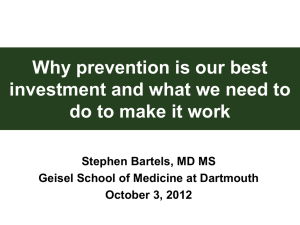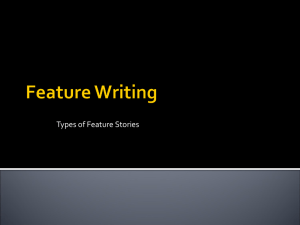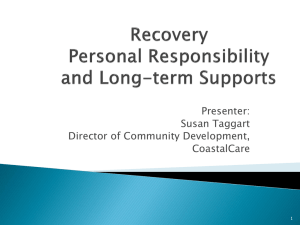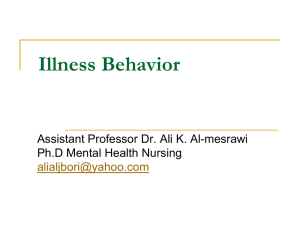Estimating Mental Illness in an Ongoing National Survey Bureau
advertisement
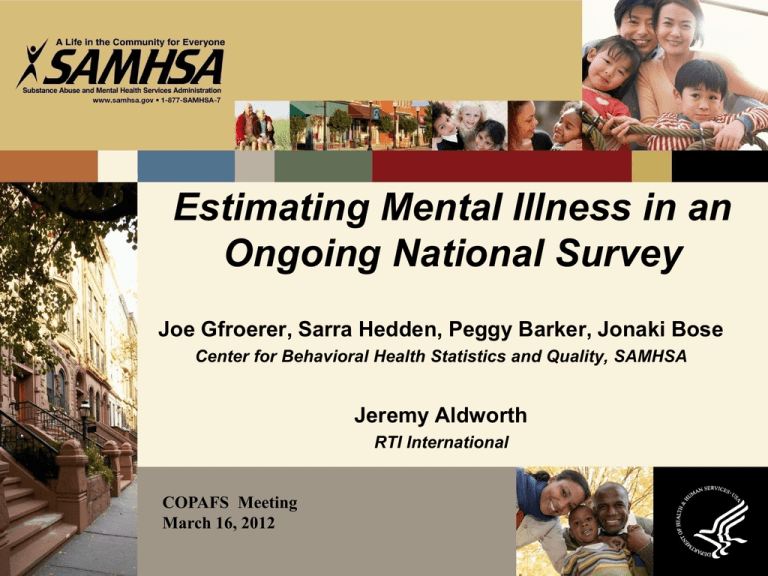
Estimating Mental Illness in an Ongoing National Survey Joe Gfroerer, Sarra Hedden, Peggy Barker, Jonaki Bose Center for Behavioral Health Statistics and Quality, SAMHSA Jeremy Aldworth RTI International COPAFS Meeting March 16, 2012 Outline of Presentation • Summary of National Survey on Drug Use and Health (NSDUH) • Design of Mental Health Surveillance Study (MHSS) • Results • Methodological issues National Survey on Drug Use and Health (NSDUH) • Sponsor: Substance Abuse and Mental Health Services Administration (SAMHSA), Center for Behavioral Health Statistics and Quality (CBHSQ) • Purpose: Estimate prevalence, correlates and trends of substance use in U.S. • History: Conducted since 1971, annually since 1990 3 NSDUH Design • Representative nationally and in each state • Civilian, noninstitutional population, age 12+ • Face-to-face interview using ACASI • 68,000 respondents each year; oversample age 12-25 • $30 incentive • Response rates (weighted, 2010): • 88% of selected households completed screener • 74% of selected persons completed interview 4 NSDUH Sample Design: Target Sample Sizes by State and Age Group • Completed Interviews per State • Large states (8): 3,600 per year • Small states (43): 900 per year • Completed Interviews by Age Group • 1/3 of sample in each age group (12-17, 18-25, 26+) 5 NSDUH Questionnaire • Use of alcohol, tobacco, and illicit drugs • Substance use disorders (DSM-IV) • Substance use and mental health treatment • Health conditions, service utilization • Demographics • Mental health (MDE, suicide) 6 NSDUH Mental Health Surveillance Study (MHSS) • SAMHSA legislation requires the agency to produce methods to estimate serious mental illness (SMI) (and serious emotional disturbance (SED) in children) • TAG (2006) recommended NSDUH for SMI (and NHIS for SED) • MHSS implemented in 2008 NSDUH 7 SAMHSA Definition of Serious Mental Illness (SMI) among Adults Any DSM-IV mental disorder (other than developmental and substance use disorders) WITH serious functional impairment (both in past year) Estimating SMI in NSDUH • A complete diagnostic assessment to determine SMI is not feasible in NSDUH interview • Would require too many questions • Interviewers are not clinicians • Alternative approach used by SAMHSA: • Administer clinical interviews on a subsample of NSDUH respondents, to diagnose SMI • Include short scales in main NSDUH interview, to be used as predictors of SMI in a model: K6, WHODAS • Develop a regression model, based on subsample data, and apply to main sample data to predict SMI for each respondent Kessler 6-item Nonspecific Psychological Distress Scale (K-6) • Included in NSDUH and several other large national surveys • Developed specifically for use in large surveys • Discriminates between cases and non-cases in community samples • Demonstrates consistency across population groups • Responses 0-4 for each item; combined score 0-24 Percentage Distribution of K6 Scores among Persons Aged 18 or Older: 2008 Percentage 25 22.4 20 15 10.710.6 9.4 10 7.9 6.1 5.3 4.0 5 3.3 2.7 2.5 2.0 2.6 1.6 1.4 1.1 1.1 1.0 1.4 0.5 0.5 0.4 0.3 0.2 0.8 0 0 1 2 3 4 5 6 7 8 9 10 11 12 13 14 15 16 17 18 19 20 21 22 23 24 K6 Score Measuring Impairment in NSDUH Main Sample: WHODAS • WHO Disability Assessment Schedule (WHODAS) • 16 items assessing functional impairments in various domains • Reduced to 8 items for NSDUH based on IRT analysis • Responses: 0 to 3 for each item Clinical Interview Subsample • At end of NSDUH interview, a request for 2nd interview on mental health is made to respondents selected for the clinical followup interview • $30 incentive • N=500 to 1500 per year • Nationally representative, stratified sample • Interview conducted by a trained clinical interviewer, by telephone, 2-4 weeks after main interview 13 Clinical Interview Content • Structured Clinical Interview for DSM-IV (SCID): 15 specific mental disorders are covered • Global Assessment of Functioning scale (GAF) 14 Estimation Step 1: Determine Best Weighted Logistic Regression Model Using Clinical Interview Subsample Let π = Pr(“true” SMI│X1, X2) logit(π) = b0 + b1X1 + b2X2 • X1 = recoded K6 score (0-17) • X2 = recoded WHODAS score (0-8) Estimation Step 2: Determine MinimumBias Cutpoint from Clinical Interview Data 1. Based on model, each CI respondent has predicted Pr(SMI+) = ˆ 2. Based on clinical interview, each CI respondent has a “true” SMI diagnosis 3. Select cutpoint, 0 , for which false positives equal false negatives in the CI subsample - If - If ˆ 0 then predicted SMI status = positive ˆ 0 then predicted SMI status = negative Final Model Based on 2008 Clinical Interview Data logit(ˆ) = -4.7500 + 0.2098X1 + 0.3839X2 Where X1 = recoded K6 score (0-17) X2 = recoded WHODAS score (0-8) Cutpoint: 0 = 0.26972 17 Estimation Step 3: Apply Model to Main Sample 1. Based on model, and reported K6 and WHODAS scores, each NSDUH respondent has predicted Pr(SMI+) = ˆ ˆ 0 then SMI status = yes If ˆ 0 then SMI status = no 2. If ROC Statistics: Final SMI Model with K6 and WHODAS vs. Alternative Model with K6 Only Model Predicted False False Sensi- SpeciParameters Rate Pos. Neg. tivity ficity Rate Rate K6 .046 .029 .028 .387 .971 Area Under ROC Curve .679 K6 and WHODAS .047 .024 .023 .506 .976 .741 19 Levels of Mental Illness Secondary purpose of the MHSS was to generate estimates of “any mental illness” and to designate levels of severity: Level of MI in Past Year Definition Low/Mild Mental Illness (LMI) Any disorder, and GAF>59 Moderate Mental Illness (MMI) Any disorder, and GAF 51-59 Serious Mental Illness (SMI) Any disorder, and GAF<51 TOTAL/Any Mental Illness (AMI) Any disorder Estimating Other Levels of Mental Illness • Various models were compared • Result: The SMI model, with different cutpoints, was found to predict as well as any other model AMI/ SMI Prediction Based on Recoded K6 and WHODAS Scores Recoded WHODAS Score 8 7 SMI 6 5 4 LMI or MMI 3 2 No MI 1 0 0 1 2 3 4 5 6 7 8 9 Recoded K6 Score 10 11 12 13 14 15 16 17 Prevalence of Mental Health Problems among Adults (18+): 2010 Percent with disorder/problem in past year 25 20 20 15 10 6.8 5 5 3.8 46 mil 11 mil 15 mil 9 mil 0 Any Mental Illness Serious Mental Illness Major Depressive Serious Thoughts of Episode Suicide 23 Fig MH 2.1 Any Mental Illness in the Past Year among Adults Aged 18 or Older, by Age and Gender: 2010 Percent with Any Mental Illness (AMI) in the Past Year 35 29.9 30 25 20 23.0 22.1 20.0 16.8 14.3 15 10 5 0 18 or Older 18 to 25 26 to 49 Age Group 50 or Older Male Female Gender 24 Fig MH 2.2 Serious Mental Illness in the Past Year among Adults Aged 18 or Older, by Age and Gender: 2010 Percent with Serious Mental Illness (SMI) in the Past Year 9 7.7 8 7 6.5 5.8 6 5 5.0 4 3.2 3.4 50 or Older Male 3 2 1 0 18 or Older 18 to 25 26 to 49 Age Group Female Gender 25 Fig MH 2.9 Receipt of Mental Health Services among Adults Aged 18 or Older, by Level of Mental Illness: 2010 Percent Receiving Mental Health Services in the Past Year 26 Fig MH 4.1 Past Year Substance Use among Adults Aged 18 or Older, by Any Mental Illness: 2010 Percent Using Substance Marijuana Illicit Drugs1 1 Cocaine Psychotherapeutics Inhalants Hallucinogens Heroin Illicit Drugs include marijuana/hashish, cocaine (including crack), heroin, hallucinogens, inhalants, or prescription-type psychotherapeutics used nonmedically. 27 Fig MH 4.2 Past Year Substance Dependence or Abuse and Mental Illness among Adults Aged 18 or Older: 2010 SUD and Mental Illness SUD, No Mental Illness 11.2 9.2 Million Million 20.3 Million Adults Had SUD 36.7 Million Mental Illness, No SUD 45.9 Million Adults Had Mental Illness SUD = substance use disorder. 28 Fig MH 4.4 Past Year Substance Dependence or Abuse among Adults Aged 18 or Older, by Level of Mental Illness: 2010 Percent Dependent or Abusing Substance 29 Issue: Trend Measurement Options: • Update models, parameters, and/or cutpoints each year • Small annual sample high variance • Continue to accumulate clinical interview data and evaluate models; update model when there is evidence that estimates can be substantially improved • Will need to update all prior estimates Prevalence of Mental Illness among Adults (18+): 2008 to 2010 Percent in past year 25 20 19.5 19.9 20.0 2008 2009 2010 15 10 4.4 5 4.8 5.0 0 Any Mental Illness Serious Mental Illness 31 Issue: Nonresponse Bias and Weighting CI Sample Disposition, 2008-2009: Unwtd. Unwtd. N Pct. TOTAL Wtd. Pct. 3,062 100.0 100.0 2,027 66.2 59.5 Immediate refusal 420 13.7 24.3 Agreed, but noncontact 477 15.6 12.5 Other nonresponse 138 4.5 3.7 Respondents Nonresponse Bias Assessment: Rates of Key Measures among Respondents, Refusals, and Noncontacts: Clinical Interview Sample, 2008-9 Percent in Past Year 20 18 16 14 12 10 8 6 4 2 0 18.2 17.1 15.5 15.0 9.9 4.9 5.6 5.5 5.3 3.7 1.3 1.9 Suicide Thoughts Perceive MH Tx Need Respondent (60%) Rec'd MH Treatment Refusal (24%) Marijuana Use Noncontact (13%) 33 Nonresponse Bias Assessment: Age and Family Income among Respondents, Refusals, and Noncontacts: Clinical Interview Sample, 2008-9 Percent 35 29.7 30 25 20 19.8 16.8 15 10 12.0 9.2 9.7 Age 18-25 <$20K Income 5 0 Respondent (60%) Refusal (24%) Noncontact (13%) 34 Other Issues • What is the best sample design? • Optimize for modeling? • Prevent extreme weights • What is best estimation method? • Variance estimation not straightforward • Estimate prevalences of specific disorders from the clinical interview sample? Conclusions • MHSS provides the only current data on trends in mental illness and its co-occurrence with substance use • Estimates have been widely cited and used in analyses of the impact of health care reform • Methods can be replicated in other surveys • But more work needed to refine the models and estimation methods
